Apex Elephants
African Savannah Elephants Thrive In Countries Where They Are Hunted
Originally published in the May/June 2023 issues of Safari Magazine.
By Al Weinert
I had resigned myself to never getting an elephant. My journey started in 2018 when I booked a hunt with PH and good friend Dale “Donza” Desfountain.
In the Zambezi escarpment of Zimbabwe, there were good populations of buffalo and sable, as well as the opportunity for a bull elephant. We had multiple encounters with sable and buffalo and were able to harvest some excellent trophies, but elephants proved to be elusive.
We were encountering elephant tracks, but unfortunately the elephants had mastered the art of nocturnal raids into our hunting concession, exiting before daylight as if wearing some form of pachyderm Cinderella slippers. We did make several stalks on herds of elephant cows and calves, but finding a bull was tough.
At the end of the hunt, Donza invited me back to try my luck in 2019. We would hunt elephant on his hunting concession in the Savé Valley Conservancy in southeast Zimbabwe’s Lowveld.
In March of 2019, my wife and I made the journey from Montana to Zimbabwe and were soon ensconced in comfortable tent lodging on the 130,000-acre Msaize concession.
On our first day of hunting, we immediately cut fresh elephant spoor and after a couple hours of tracking, we were able to locate four elephant bulls feeding in dense riverine vegetation along a dry riverbed. To me they all looked big, but after carefully studying the bulls from 100 to 200 feet, Donza felt they were either too young or didn’t have the ivory we were after.
We departed, leaving them undisturbed. Other than a two-day foray, during which we successfully pursued buffalo, we spent the remainder of the hunt on elephant, including one ancient Methuselah bull whose tracks had cavernous fissures resembling a giant tortoise shell.
Unfortunately, we never caught up with him. We had several additional encounters with herds of young bulls and one very large bull with a broken tusk, but nothing that fit the bill.
Not to be deterred, Donza graciously extended an invitation for me to return in July to “finish the business.” After 30 hours of travel, I found myself back in the Msaize concession on the premise that “third time’s the charm.”
On this trip, I was accompanied by my older daughter and her husband who is a professional videographer and who would film the hunt and take in Africa. One may rightfully ask what insanity would drive a person to make three trips to Africa in the pursuit of the “right” elephant, but I was comforted by the reassurance that I was not alone in this affliction.
The African savanna elephant (Loxodonta africana) is among the most iconic African megafauna. At 10-12 feet tall at the shoulder and weighing 12,000-14,000 pounds, it is the largest land mammal on the planet.
Elephant tusks are incisors that grow throughout an elephant’s lifetime. Ivory has been coveted since antiquity for its patina, semi-translucent quality and ability to be carved. The African ivory trade dates back to the 14th century BC. In 1800, an estimated 26 million elephants roamed the continent of Africa. During the colonial period between 1800-1900, the European commercial ivory trade drastically reduced the elephant population to 5 million by 1920 and 1.3 million by 1979.
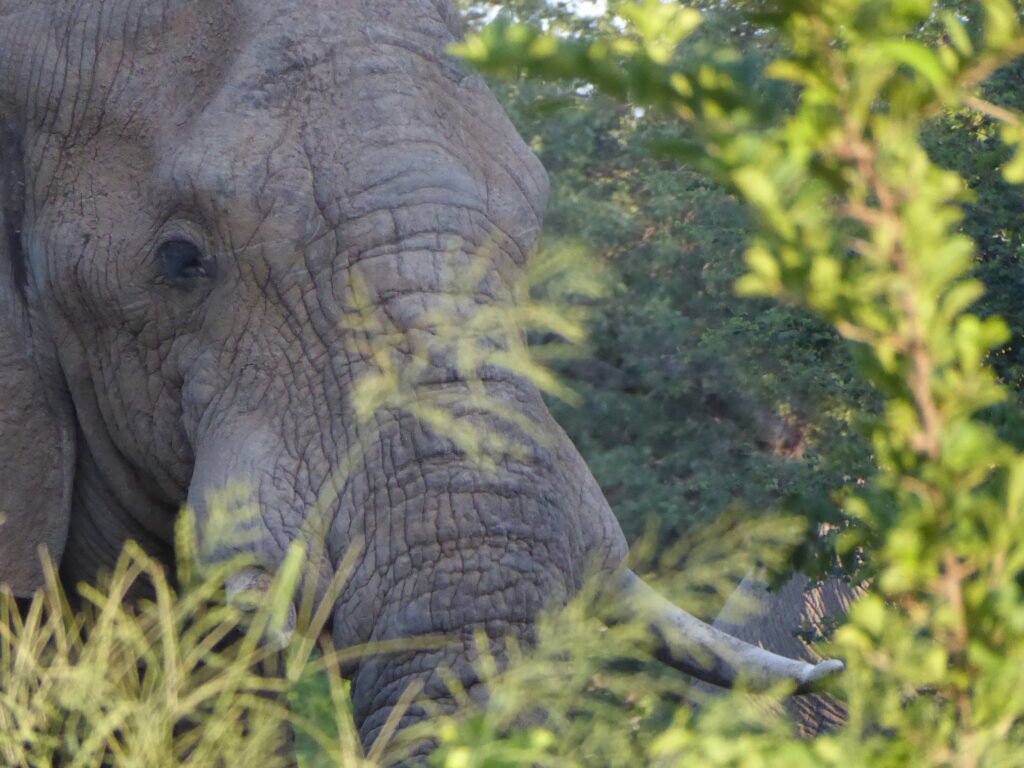
In 1988, the U.S. Congress passed the Elephant Conservation Act prohibiting the commercial importation of ivory into the U.S. and in 1989 The Convention on the International Trade in Endangered Species of Wild Fauna and Flora (CITES) announced the international ban on the commercial trade of raw ivory.
However, China continued to allow domestic ivory trade and illegally traded ivory was widespread. This fueled corporate syndicate poaching throughout Africa. It was not until 2017 that China also banned the commercial trade of ivory. Poaching and the commercial trade of ivory should not be confused with the legal, scientifically regulated sport hunting of elephants which the U.S. Fish and Wildlife Service and most sub-Saharan nations have determined is “beneficial to the conservation of the species,” and puts “much-needed revenue back into conservation.”
Case in point is that the sub-Saharan African nations that allow elephant hunting have seen significant increases in elephant populations: Botswana has as many as 130,000 elephants with an estimated carrying capacity of 50,000. Zimbabwe has nearly 100,000 elephants with an estimated carrying capacity of 45,000, Namibia has 22,000 and South Africa has more than 20,000. Learn more here.
Most of these populations are growing by roughly 5% annually. In contrast, elephant populations in many parts of central and west Africa, where elephant hunting is not allowed, are declining.
The problem is that suitable elephant habitat is finite, and the human population of Africa has the most rapid growth of anywhere in the world, anticipated to double by 2050 and accounting for one in every four births on the planet.
This formula increases the potential for human-elephant conflict, including property damage, crop damage and loss of life. Currently, between 100-500 elephant-caused human deaths occur annually in Africa. In America, if grizzly bears killed 500 humans per year the only remaining grizzlies in the continental U.S. would be found in zoos, museums and your great uncle’s trophy room.
As Peter Capstick describes in “Death in the Long Grass,” most Americans appreciate elephants as “big gray good-natured slobs who spend their time running in terror from mice, vacuuming up peanuts and remembering things.” To the rural African, living with elephants can be deadly.
As my PH described it, “if an elephant gets you by the trunk, he will use you like a baseball bat. They will normally pick you up by the leg and slam you to the ground or against a tree. Your body will explode, and it won’t stop there. He will rip you to pieces.”
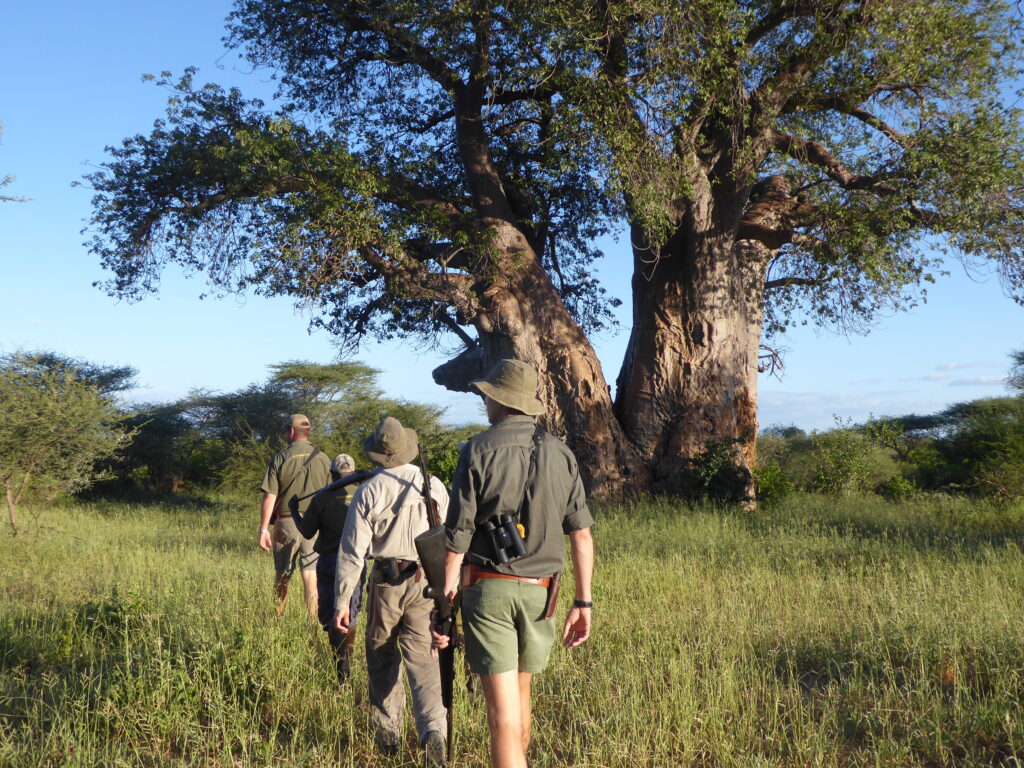
Later in our hunt, we were tracking two bull elephants intermingled with a herd of cows and calves in very thick bush. Donza sent one of the trackers up a tree to get a visual on the bulls.
As Andrew slid down the tree, we felt the wind shift to our back and a disapproving group of cows started our way in a significant state of consternation. Our brave PH’s advice was “run” and as we high-tailed it through the brush with the trackers on our heels, Donza covered our retreat with his .600 Nitro Express at the ready. I have come to realize that elephants can be unpredictable and when hunted the right way, at close range with open sights, things can go wrong in a hurry!
HUNTING IS CONSERVATION
Elephants are considered important ecosystem engineers in Africa’s savannah communities. They feed by stripping bark with their tusks as well as breaking branches and uprooting trees with their muscular trunks, eating over 400 pounds of vegetation daily.
Areas with elephant overpopulation cause loss of woodlands with local extinction of some tree species that leads to a habitat conversion of sparse shrubland due to browsing pressure. Reduction of canopy cover causes a reduction in small herbivores due to increased vulnerability to predation. It also results in a negative impact on species richness, particularly among woodland birds.
Studies demonstrate that elephant densities of 0.3 animals per square kilometer reduce woody plant species as well as bird and invertebrate species diversity. At elephant densities of less than 1 elephant per square kilometer, woody biomass was reduced by 45% over four years and canopy cover declined from 75% to 10% in 14 years. Currently, elephant populations in Zimbabwe’s Hwange National Park exceed 3 elephants per square kilometer, causing extensive ecological damage.
The role of well-managed hunting in benefitting wildlife habitat and species is undeniable, preserving 22% more wild ecosystems than all the national parks in sub-Saharan Africa combined. Trophy fee payments provide employment for local Africans, fund anti-poaching patrols, provide a source of protein for local communities, fund infrastructure projects including water development, school investments, medical facilities and road improvements. Hunting conservancies give wildlife value in the eyes of local Africans and makes living in the presence of dangerous game such as elephants an asset rather than a liability.
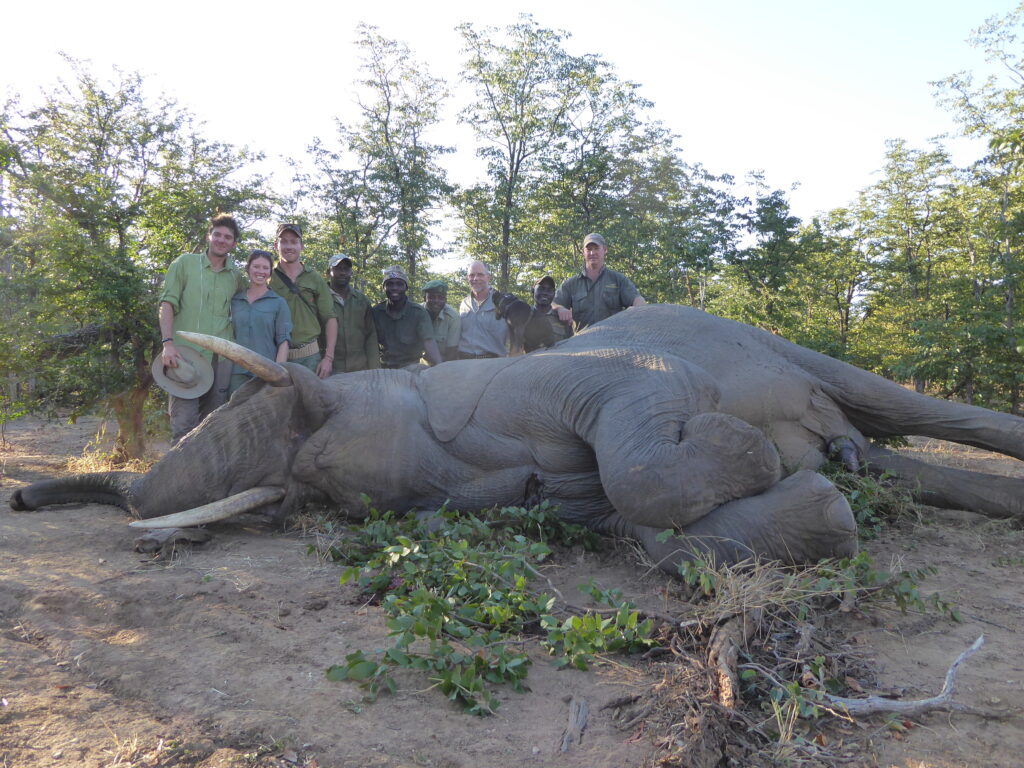
Over a dozen African nations use trophy hunting revenue to enhance conservation and preserve natural ecosystems. More than 344 million acres of wildlife habitat in sub-Saharan Africa is preserved through hunting concessions.
Most of this land is remote with less infrastructure and less animal concentrations and scenic value that would be necessary to sustain a photo safari operation.
Hunting concessions are also marginal for agricultural purposes due to their difficult terrain and a lack of readily available water resources for livestock. Hunting operations leave less of a footprint, require less infrastructure, and involve less traffic than photo tourism.
The overwhelming majority of African hunting operations are based in Africa, and hunting fees are more likely to contribute to local communities. Photo tourism businesses are often based outside of Africa and most of the expenses never make it into the African economy. Those that do are very localized around the national parks.
Under the Campfire program in Zimbabwe, at least half of the revenue derived from leasing trophy hunting concessions goes to local communities for rural development and environmental conservation and the meat from those is given directly to the local communities.
The Tanzanian Wildlife Management Authority obtains 60% of its funding through trophy license fees. In Tanzania, it is estimated that one hunter has the same economic impact on the local community as 29 photo tourists.
In Namibia, legislation was enacted after independence in 1990 that created Community Based Natural Resource Management Programs to benefit local communities from wildlife resources.
In all, 40% of Namibia is under conservation management with greater than 70 community-run nature conservancies managed for both eco- and hunting tourism. Moreover, under Namibian law 100% of the income from hunting in these conservancies goes to local communities.
Contrast the elephant conservation success of those sub-Saharan nations that allow sport hunting of elephants to Kenya, which was the desired destination for hunting safaris by the likes of Theodore Roosevelt, Ernest Hemingway, Robert Ruark, and many others because of its accessibility and game-rich forest and savannas.
In 1977, Kenya overturned precedence and outlawed hunting entirely throughout the country. The net result was a 68% decline in wildlife in Kenya over the next 40 years with rampant poaching and loss of wildlife habitat relating directly to the devaluation of wildlife by local Africans. Wildlife no longer had any value to them other than meat or unregulated black-market poaching for ivory and rhino horn. With no hunting, there was no funding for anti-poaching.
Between 2006 and 2016, east Africa (Kenya, Tanzania, Uganda, and Rwanda) and Kenya specifically saw the greatest decline in elephant numbers, with over a 50% decline due to corporate syndicate poaching. To learn more, sign up for SCI Foundation’s Anti-Poaching Newsletter.
LAST DAY
It was the 13th and final day of my third attempt at harvesting a bull elephant in Africa. The first attempts involved numerous encounters with elephants and elephant bulls as had this hunt, but not the right bull in regard to age or trophy.
We had been following a bull since midday and only had a few hours of light left. The bull was traveling solo, as far as we could tell, with a distinctive marking on the left front foot pad in the shape of a circle. Gauging his track, he was of moderate age and size to pursue and had frequented this area of the forest for the last several days.
Buka, our head tracker and reformed poacher, had to ferret out which tracks were the most recent to follow. The initial tracking was easy going in loose sandy soil, and we made good headway until the elephant moved into open mopane forest with very hard and dry clay soil. Even a 12,000-pound animal left little sign on cushioned cartilaginous feet. It was as if he was levitating across the land.
The mood of our safari party was decidedly grim, and I had begun to take the fatalistic attitude that it was not meant to be. The PH, assistant PH and the two trackers had fanned out in different directions, leaving me, my daughter, and my son-in-law to trade whispers. Suddenly, a resounding crack of a tree shattered the silence and trained our attention in the direction of the sound. All parties emerged from the bush with renewed confidence. There was only one reason a tree would break in the absence of wind.
We silently advanced in the direction of the sound. Donza made sure I had chambered a round and told me to take the safety off as even experienced clients often forget when experiencing a veritable mountain of flesh, trunk and tusks.
With rifle at port arms, we advanced slowly, and I became aware of a large gray muscular appendage extending from the brush. I then saw an enormous form towering in the trees directly in front of me.
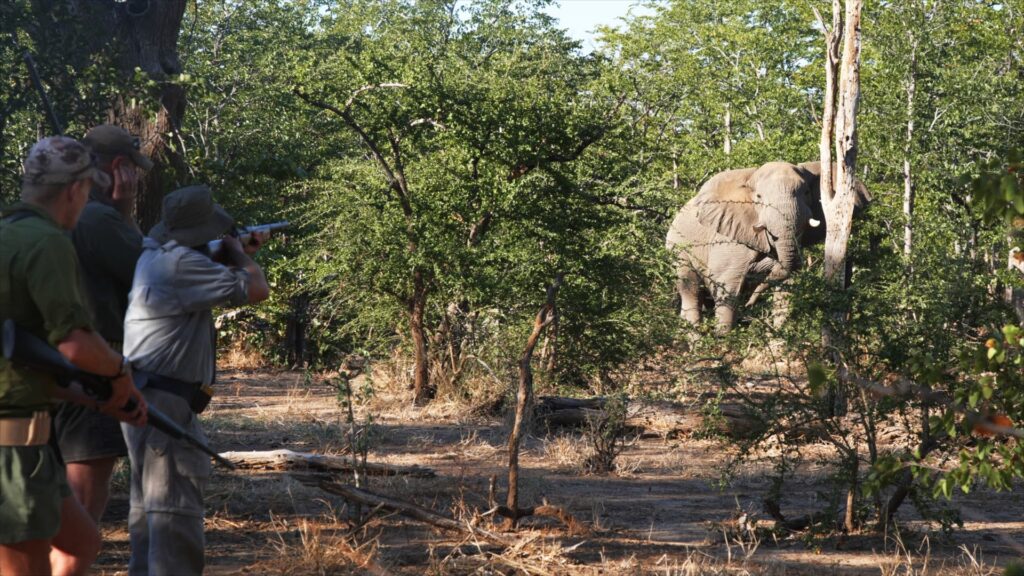
The strange gray appendage abruptly withdrew, and Donza signaled me a thumbs up as the trees parted and we were suddenly 25 yards away from the largest land mammal on Earth. My instincts took over and I was suddenly swinging my open-sighted .375 H&H like I was handling my double shotgun on a driven pheasant hunt.
Unconsciously, my front bead adjusted for the angle and attitude of the head so that I centered the projectile 3 feet back from the external auditory canal. I was not aware of the 300-grain solid leaving the barrel, but watched in awe as the rear legs collapsed and the trunk was thrown back over the animal’s head in a cloud of dust and debris. It was truly an out-of-body experience, and then I was brought back to reality by the word “Perfect!” shouted by the PH.
We both strode forward to admire what had just transpired. Although seemingly dead, I jacked another round in the chamber as I silently thanked the elephant and “paid the insurance.” With African dangerous game it is always the dead animals that kill you.
In short order, the entire camp staff descended on the scene to expeditiously process the elephant. The meat was promptly taken to the village on the other side of the river to ensure that the people who live in the presence of these amazing animals appreciate them as an asset, not only for their magnificence as an iconic African animal, but for the tangible protein and trophy dollars that improve their infrastructure, schools and medical care.
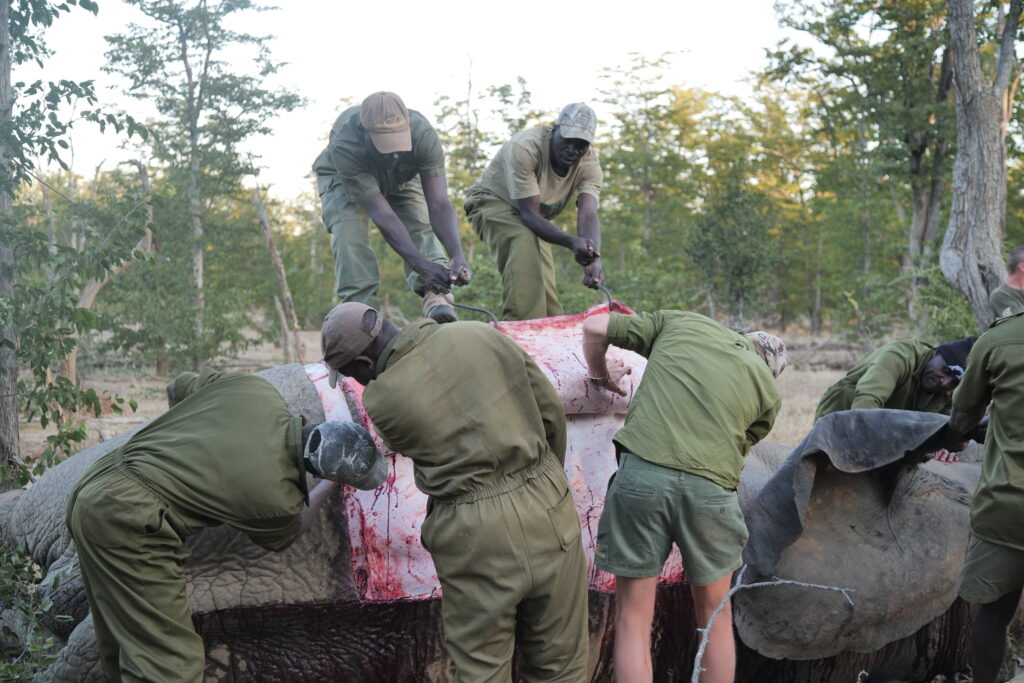
As I close my eyes and reflect on my admiration for Africa and its amazing animals, I am confident there is no paradox in the term “hunter conservationist.” The fates of wild African ecosystems and hunters remain interdependent and strong.
Beware The Musth

Musth is a lot like the rut in other animals. It is a biologic state that occurs 2-3 months per year. Testosterone levels can be 60 times higher than normal. Elephants at this time can be especially aggressive. On my third attempt at harvesting a bull elephant in Zimbabwe’s one million-acre Savé Valley Conservancy, a Cape buffalo hunter was suddenly charged by a large cow elephant that appeared out of the bush. He was able to jump back into the passenger’s side of the vehicle as the two trackers in the bed jettisoned over the side and vanished into the bush. The enraged pachyderm struck the passenger’s side door with her tusks, shattering the glass and putting a tusk through the door. Her body weight bent the heavy steel safari frame and left hide on the rack. As the hunter dove onto the PH on the driver’s side to avoid the tusks, the elephant withdrew her tusks from the door and pierced the hood of the cruiser with her tusks, lifting the cruiser on two wheels. The PH exited the driver’s door to reach his double rifle that was in the gun rack behind the cab. As the .470 Merkel touched the PH’s shoulder and the safety slid off with a metallic “click,” the elephant withdrew her tusks, spun around and walked back into the forest.
Her case had been made. It took 20 minutes before the trackers reappeared from the forest, and much longer before the hunter could find his way back to camp for a change of laundry.
Al Weinert is a semi-retired physician and SCI member who lives in Montana with his wife, four Morgan horses and two bird dogs.

